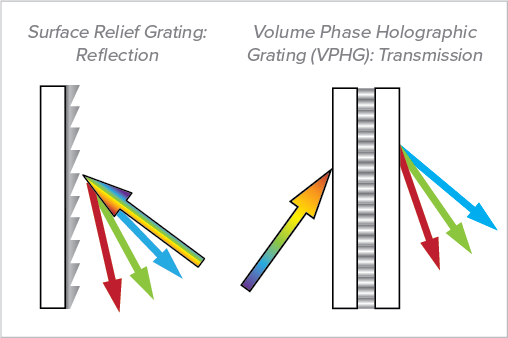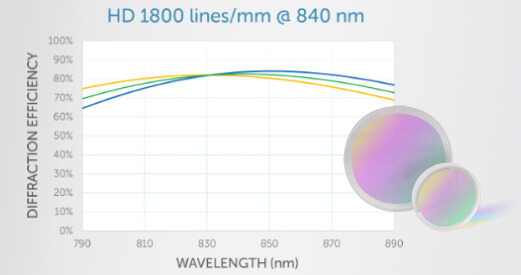


Theoretical Profile of a Ruled Blazed Grating Because of the mechanical nature of the mastering process however, there can be random and periodic spacing errors that could detract from the purity of the diffracted spectra.

Ruled blazed gratings are very efficient, and are generally the best choice for applications requiring high signal strength. The resulting groove profile has a well defined and controllable groove profile that directs energy efficiently into the desired wavelength range. The master gratings are produced by forming the surface of a soft metallic coating with a diamond form tool. Types of Diffraction Gratings Ruled, Blazed Diffraction Gratings Every wavelength undergoes a different phase shift, and as a result, diffracts at a different angle, resulting in a dispersion of broadband light. This redirection (or diffraction) is a result of the phase change of the electromagnetic wave as it encounters the regular, fixed structure of the grating surface. Want to stay ahead of the art world? Subscribe to our newsletter to get the breaking news, eye-opening interviews, and incisive critical takes that drive the conversation forward.A diffraction grating is a passive optical component that redirects light incident upon the surface at an angle that is unique for every wavelength in a given order. " Sarah Meyohas " is on view at Marianne Boesky, 509 West 24th Street, New York, through June 30. "They'll be like, 'oh, it changes color, fun,' you know? But it's okay if they don't because I just had to make it." "I hope people will see the difference, but I'm not entirely sure that they will," she added of her upscale holograms. "I get off on that," she said of the rather nerdy process. While discussing the works, she excitedly detailed the technique of turning every pixel of her photographs into a value for the machine gratings, and the dilemma of whether or not to laminate the glass panes. With her latest diffraction gratings, she sought to create "pieces that are fundamentally optical, requiring your physical presence," she noted, as opposed to work that could be "absorbed" by trending discussions of virtuality or generative A.I.Īnd Meyohas's own engagement with holographic tech runs far deeper than those finely etched surfaces. Courtesy of the artist and Marianne Boesky Gallery, New York and Aspen. Sarah Meyohas, detail of Interference #18 (2023). This has entailed turning to "a different type of engagement with technology," she said. But hers have never been idle pursuits of technology instead, they are attempts to lift the lid on the true nature and ramifications of such innovations-what it might mean to financialize art (as in 2015's Bitchcoin ), or algorithmize beauty (as in 2017's " Cloud of Petals ").

These new pieces trail Meyohas's other experiments with high-end tech, whether with the blockchain or A.I. "I like putting bodies in spaces they're not supposed to be," she added.
#Diffraction gratings windows#
Across the work's conjoined glass windows can be glimpsed three-breasted female torsos-a surreal vision that emerges from Meyohas's observation that "you really don't see nude forms anymore," whether in galleries or Hollywood movies. Meyohas's newfound interest in anatomy is also captured in Diffraction #1 (2023), a sculptural form that's part of a new series. "The idea that a regular shape or form at nanoscale can refract and create light and color on the visible spectrum, and the fact that light is dependent on your position just felt so beautiful to me." "Essentially, any color that changes based on your angle of viewing is structural color," she told Artnet News. The resulting vibrant tones seen by the human eye are known as structural color, an occurrence that Meyohas has lately found "religiously appealing." These new works are the "Rolls Royce version" of holograms, as Meyohas put it, technically known as diffraction gratings, devices with multi-lined or grooved surfaces that split light into its different wavelengths or colors. No, it's not digital trickery, but the result of Meyohas's continued adventures into holographic technology. Step in front of these mirrored panels, though, and they reveal mesmeric three-dimensional images-a cluster of plants here, a fragment of a naked female form there-all tinged with iridescent hues. Entering Sarah Meyohas's new show at Marianne Boesky Gallery, you might be forgiven for thinking the artist has simply installed a number of pitch-black glass panes across the gallery.


 0 kommentar(er)
0 kommentar(er)
